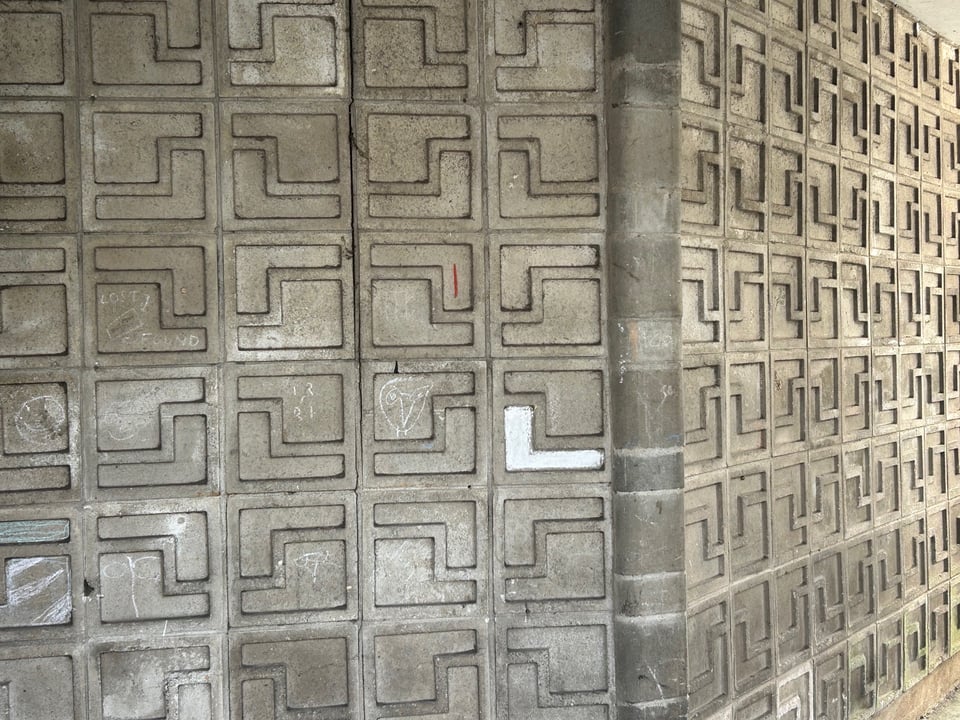Field Notes: 14 February 2025
Totnes' implausible brute, the Brutalist and a brutal wave that cut short a research session.
Most people writing about modernism probably don’t have to factor in high seas regularly. Today my planned trip to Totnes Archives was nearly washed out.
Dawlish sea wall is a marvel of engineering and nature, and a bloody stupid place to put a railway. As the train approached Dawlish today, the manager suggested people get off the train near the front, under the shelter of the old station canopy because “the waves have been a bit high”. The brute force of huge wave hit the train itself less than a minute later, shorting the engine. It wasn’t even a named storm day.
Totnes Archives are only open for three and a half hours, on a Friday, so I eventually arrived 90 minutes late and somewhat breathless from the climb up the hill to Fore Street. The archivists were wonderfully helpful, as was a regular user who had popped by to say hello to them and instantly recalled some facts that have saved me some research time.
Brutal stories
According to Geoffrey of Monmouth, the clerical ChatGPT of the twelfth century, Totnes was founded by Brutus of Troy when he stepped ashore. He then defeated some giants and claimed the land as his. Apart from Cornwall, which he gave to his pal Corineus. Then, like many people since, Brutus headed off to That London (or New Troy as he called it). A stone set in the pavement of Totnes Fore Street is said to be where he first stepped foot.
As Totnes is both a fair way inland, and six meters above sea level, this is obviously nonsense. But it’s the third thing involving the root word ‘brut’ I’ve encountered in the last three weeks.

I went to see The Brutalist (dir. Brady Corbet, 2024) towards the end of January and have also just read Concrete Concept: Brutalist buildings around the world by Christopher Beanland (pub. Frances Lincoln, 2016).
I’m still thinking about the film. I recognise the valid critiques about its (mis)use of architecture. The obsessive, uncompromising narcissistic architect is a shallow stereotype. The reading of a specific, real architect’s biography onto a fictional character is a problem since people like the simple narratives a film offer over the complex realities of a real life. But the architecture is a MacGuffin. A big, raw, brutal one but a MacGuffin nonetheless. The real story is of power and the brutal use of it. I do suspect architecture through which the idea is played out because of the opportunity to play with the word ‘brutalist’.
Reading Concrete Concept after the critiques of The Brutalist it was hard not to notice the giant Brutalist churches and cathedrals featured in it. The cropped tight photos of Sainte Marie de La Tourette by Le Corbusier could easily be stills from the end of The Brutalist. The book does enjoy saturating much of its photography with colour though, which made it something of an escape from the weather.
The Brutalist will be available to rent on streaming services soon.
Concrete Concept is still available to buy, though I got it from the library.
I’ve yet to start working on a brutalist building to feature, but the conversation at Totnes Archives today did turn to one that’s tucked away in a side street of the town.
Local news of modernist buildings
Poole’s old Arndale partially closed
Poole’s unloved Arndale opened in 1969, and includes a library, shops and council offices.

Dolphin centre Poole: Offices closed after Raac is found in roof | Bournemouth Echo
Staff have been removed from the Dolphin centre over safety fears after unstable concrete was found in part of the building’s structure.
I’m working on the next deep dive, which covers a fire, punks and stilts. If you would like to get early access to deep dives, you can upgrade your subscription.
The deep dive on Rennes House is available for free (link below).